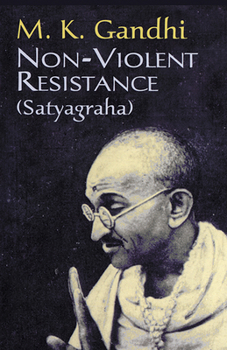Non-Violent Resistance
Select Format
Select Condition 
Book Overview
Mohandas Gandhi gained the deep respect and admiration of people worldwide with both his unwavering struggle for truth and justice and his philosophy of non-violent resistance -- a philosophy that led India to independence and that was later taken up by the American civil rights movement. This volume presents Gandhi's own clear and consistent vision of that philosophy, which he calls Satyagraha -- literally, "holding on to the truth." Through Satyagraha, one brings about change by appealing to the reason and conscience of the opponent and puts an end to evil by converting the evil-doer.
The book begins with an introductory explanation of Satyagraha, including a description of how it differs from passive resistance and what it has in common with the civil disobedience of Thoreau and non-cooperation in general. It proceeds with detailed discussions of discipline and self-control, including living simply, recognizing the unity of all loving beings, and serving one's neighbors wholeheartedly; the courage and training necessary for the Satyagrahi; successful on-cooperation and civil disobedience; political power and Satyagraha, the development of a non-violent army; the use and effectiveness of such techniques as non-payment of fines and taxes, social boycotts, fasting, sympathetic strikes, and other forms of non-cooperation; women and picketing; and many other topics.
Invaluable to ethicists, political philosophers, students, and participants in the ongoing struggle for human rights, this inspiring book is as relevant today as it was when first published half a century ago.
The book begins with an introductory explanation of Satyagraha, including a description of how it differs from passive resistance and what it has in common with the civil disobedience of Thoreau and non-cooperation in general. It proceeds with detailed discussions of discipline and self-control, including living simply, recognizing the unity of all loving beings, and serving one's neighbors wholeheartedly; the courage and training necessary for the Satyagrahi; successful on-cooperation and civil disobedience; political power and Satyagraha, the development of a non-violent army; the use and effectiveness of such techniques as non-payment of fines and taxes, social boycotts, fasting, sympathetic strikes, and other forms of non-cooperation; women and picketing; and many other topics.
Invaluable to ethicists, political philosophers, students, and participants in the ongoing struggle for human rights, this inspiring book is as relevant today as it was when first published half a century ago.
Format:Paperback
Language:English
ISBN:0486416062
ISBN13:9780486416069
Release Date:May 2001
Publisher:Dover Publications
Length:432 Pages
Weight:1.02 lbs.
Dimensions:1.1" x 5.4" x 8.3"
Customer Reviews
5 ratings
Such an inspirational reading.
Published by Thriftbooks.com User , 15 years ago
While I agree with previous reviewers that the writing quality on this book is not the best, I have to admit the insight is amazing. Gandhi's ideals are an inspiration in my life and I am anxious to keep reading his work.
So very few
Published by Thriftbooks.com User , 18 years ago
So very few books could boast truly world-changing ideas like this one. The effects of Ghandi's teachings have of course spread far beyond the struggles in South Africa and India to the civil rights movement in the US and more. Non-violence has never been weighed and found wanting, it has been weighed, found difficult and ignored. But, in the end, the way that looks easier, the way of violence, is the truly hard path to follow. What seems the longest road is not necessarily the most difficult to travel. We all need to review Ghandi from time to time and regain that other path away from self-destruction.
concretizes Gandhi's ideas
Published by Thriftbooks.com User , 18 years ago
I liked this book because it makes Gandhi's ideas concrete and specific. He talks about how to handle specific situations, and explains his thinking - for example, his view of picketing. Specific examples of how to handle specific situations give you more insight into what non-violent resistence and non-cooperation really mean as applied to real life situations. After reading this book, you have a much better sense of how to apply Gandhi's ideas, versus just an overview of his ideas as abstraction.
WOW, Essential Gandhi!
Published by Thriftbooks.com User , 18 years ago
I loved this book from cover to cover. It's an amazing story of one man's non-violent battle against the food-arazzi. Okay, truth be told, I skimmed through the first half but the part where Gandhi went on the hunger strike was a total inspiration to me and my Pro Ana group. Gandhi lived his life just like we do...but he did it first! He knew about the evils of food long before it was popular to say so. He starved so that we may starve too. If you ask me Gandhi was like the American Jesus. I think he wore sandals too!! And that's what make him a REAL American hero!!! P.S. If you get too hungry you can eat this book. LOL. Kidding. Don't eat ANYTHING! EVER!
purna swaraj
Published by Thriftbooks.com User , 23 years ago
I learned a great deal from Mahatma Gandhiji (1869-1948) by reading NON-VIOLENT RESISTANCE. This book is a collection of articles written at the hand of Gandhiji for the magazines "Young India" and "Harijan". In addition, there are some interviews. The term Satyagraha was authored by Gandhiji to describe the process of non-violent resistance. Satyagraha has as its goal reform. It requires a great deal of discipline on the part of the participants. It also requires an opponent that is capable of reform. I have been applying what I have learned from this book in an attempt to reform myself. If you are interested in the life of Mahatma Gandhiji, or in the process of non-violent resistance, this book will be interesting to you.





